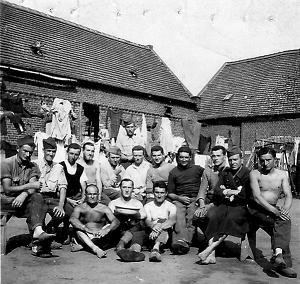Type Prisoner-of-war camp | In use 1939-1945 | |
 | ||
Stalag III-C was a German Army World War II POW camp for Allied soldiers. It was located on a plain near the village of Alt Drewitz bei Küstrin in the Neumark of the state of Brandenburg, (now Drzewice, Kostrzyn nad Odrą, Poland), about 50 mi (80 km) east of Berlin.
Contents
Initially the camp served as a place of internment for several thousand soldiers and NCOs from Poland, France, Britain, Yugoslavia and Belgium. From 1943, a number of Italian POWs were also held there. From 1944, soldiers from the United States of America were kept there too. The majority of the Soviet prisoners (up to 12,000) were killed or starved to death. Most of the lower rank prisoners were sent to Arbeitskommandos to work in industry and on farms in Brandenburg. However the administration stayed with the Stammlager.
Timeline
Escapes
Joseph Beyrle was a paratrooper in the 506th Parachute Infantry Regiment of the 101st Airborne Division. Captured in Normandy in June 1944 he was taken to a POW camp. He escaped twice, and when recaptured he was sent to Stalag III-C. Early in January 1945 he escaped again and made his way to a Soviet tank battalion. He convinced the legendary tank brigade commander Alexandra Samusenko (allegedly the only female tank officer of that rank in World War II) to allow him to fight with them. He is believed to be the only American serviceman to have actually fought in a Soviet unit. Wounded during a German air attack, he was evacuated to a Soviet military hospital, from where he was sent to Moscow to the U.S. Embassy. (His son, John Beyrle, returned there to serve as United States Ambassador to Russia 2008–2012.)
Walter Mehlhaff was captured 19 September 1944 during while fighting with the 16th Infantry, 1st Infantry Division, on the German border. Imprisoned at Stalag III-C, he escaped from a work group early in January 1945. He made his way towards Poland and finally was taken to Odessa for repatriation.
Cpl. Gustav Christian Brucker of Philadelphia PA was captured near Mortain France in August 1944 and was sent to Stalag III-C until the camp was liberated in early 1945. He did speak some German and helped with translating for fellow POW's. He recalled living on mostly stale bread and turnip soup during his days in III-C. He was discharged from the USA in Nov 1945. He died in 2004 on hospice at his daughter Kathy Brucker Haywood's home just outside Philadelphia.
